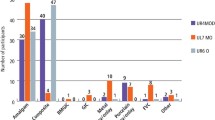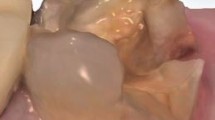Key Points
-
Amalgam continues to predominate as the restorative material of choice for the restoration of permanent teeth.
-
Glass-ionomer cements are widely used as luting cements and as bases and restorations by younger practitioners.
-
Rubber dam is not used routinely.
-
Stainless steel crowns are placed by a minority of practitioners for the restoration of deciduous molars.
Abstract
Objectives To investigate by questionnaire, the use and selection of materials and techniques for the placement of direct restorations and the provision of endodontics and bleaching by dental practitioners in the North West of England and Scotland.
Methods A questionnaire was sent to 1,000 general dental practitioners selected at random from dentists in Scotland and the North West of England. Non-responders were sent another questionnaire after a period of 4 weeks had elapsed.
Results A total of 701 usable questionnaires were returned, giving a response rate of 70%. The most commonly used material for the restoration of Class II cavities in premolar and permanent molar teeth was amalgam (n = 605, 86%) and (n = 634, 90%) respectively. Many practitioners (n = 419, 60%) felt amalgam should continue to be used but a majority (n = 374, 66%) remained unconvinced about the merits of amalgam bonding. A minority (n = 63, 9%) of practitioners used predominantly directly placed resin composite rather than amalgam to restore Class II cavities in premolar and permanent molar teeth. Home-based vital bleaching was provided by a significant number (n = 245, 35%) of practitioners with only 18% (n = 123) providing practice-based bleaching. The most commonly used endodontic obturation technique was cold lateral condensation (n = 527, 75%) with 61% (n = 425) of respondents not using rubber dam routinely for endodontics.
Conclusions For the practitioners in this survey, amalgam was the most frequently selected direct restorative material. Few practitioners used amalgam bonding let alone direct resin composite for posterior restorations. Home-based rather than practice-based bleaching procedures were preferred, as were more traditional endodontic obturation techniques.
Similar content being viewed by others
Log in or create a free account to read this content
Gain free access to this article, as well as selected content from this journal and more on nature.com
or
References
Burke FJT, Wilson NHF, Christensen GJ, Cheung SW, Brunton PA . Contemporary dental practice in the UK: demographic data and practising arrangements. Br Dent J 2005; 198: in press.
Brunton PA, Christensen GJ, Cheung SW, Burke FJT, Wilson NHF . Contemporary dental practice in the UK: Indirect restorations and fixed prosthodontics. Br Dent J 2005; 198: in press.
Mjör IA . Repair versus replacement of failed restorations. Int Dent J 1993; 43: 466– 472.
Jokstad A, Bayne S, Blunck U, Tyas M, and Wilson N . Quality of dental restorations. FDI Commission Project 2-95. Int Dent J 2001; 51: 117– 158.
Annual Digests of Statistics (2000-2002). Eastbourne: Dental Practice Board.
Wilson NHF . Evaluating materials: relationships between laboratory investigations and clinical studies. Oper Dent 1990; 15: 149– 155.
Burke FJT, McHugh S, Hall AS, Randall RC, Widstrom E, Forss H . Amalgam and composite used in UK general dental practice in 2001. Br Dent J 2003; 194: 613– 618.
Greenwall L . Bleaching techniques in restorative dentistry. London: Martin Dunitz, 2001.
Randall RC, Vrijhoef MMA, Wilson NHF . Efficacy of preformed metal crowns vs. amalgam restorations in primary molars: A systematic review. J Am Dent Assoc 2000; 131: 337– 343.
Author information
Authors and Affiliations
Corresponding author
Additional information
Refereed Paper
Rights and permissions
About this article
Cite this article
Wilson, N., Christensen, G., Cheung, S. et al. Contemporary dental practice in the UK: aspects of direct restorations, endodontics and bleaching. Br Dent J 197, 753–756 (2004). https://doi.org/10.1038/sj.bdj.4811905
Received:
Accepted:
Published:
Issue date:
DOI: https://doi.org/10.1038/sj.bdj.4811905
This article is cited by
-
Dental practice in the UK in 2015/2016. Part 4: changes since 2002?
British Dental Journal (2019)
-
Dental practice in the UK in 2015/2016. Part 2: aspects of direct restorations, bleaching, endodontics and paediatric dentistry
British Dental Journal (2019)
-
Clinical studies on core-carrier obturation: a systematic review and meta-analysis
BMC Oral Health (2017)
-
3D analyses of interface voids in root canals filled with different sealer materials in combination with warm gutta-percha technique
Clinical Oral Investigations (2014)
-
Contemporary dental practice in the UK: demographic details and practising arrangements in 2008
British Dental Journal (2012)



